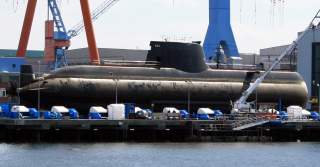South Korea's Submarine Force Could Someday Carry Nuclear Weapons
Watch out, North Korea.
One of the most underreported aspects of the Republic of Korea (ROK) armed forces is its submarine force. A relatively recent development, the ROK’s submarine arm is taking on increased importance in light of North Korean nuclear, missile and submarine developments. This force would not only chase Pyongyang’s missile boats, but also shelter for South Korea’s own nuclear arms—if it decides to build them.
Located on a peninsula adjacent to the Pacific Ocean, South Korea is naturally a maritime-oriented nation. Unfortunately, Seoul’s emphasis on countering North Korea and its large ground forces dominated South Korean military priorities for decades, leaving little room for naval forces. A growing South Korean economy, along with the low personnel costs associated with conscription, has enabled the country to gradually expand its naval power.
As late as 1976 the ROK Navy (ROKN) consisted of a handful of destroyers and destroyer escorts, minesweepers, patrol craft and amphibious landing craft. The navy was primarily configured to counter North Korea’s large number of patrol boats and landing craft, and also to support the ROK Marine Corps in amphibious warfare. In February 1988, the government in Seoul decided to commit to the establishment of a submarine force.
What a War Between NATO and Russia Would Look Like.
South Korea’s first attack submarine was SS-61, also known as Jang Bogo. Built in Germany, she was a Type 209 diesel electric boat that displaced 1,285 tons submerged and had a crew of thirty-five. She had eight bow-mounted 533mm torpedo tubes and was typically armed with fourteen STN Atlas Electronik SUT Mod. 2 heavyweight torpedoes. Alternately she could carry twenty-eight mines, and some ships in the class that followed were modified to launch the submarine version of the American-made Harpoon missile.
What a War Between America and China Would Look Like.
Eight more Type 209s followed, boats two and three constructed from subassemblies shipped from Germany. The submarines were gradually “Koreanized,” steadily introducing Korean-made parts with each new boat as they became available. According to the authoritative Combat Fleets of the World, South Korea’s Type 209s are reportedly the quietest of the type ever made due to sound-damping rafting of machinery.
The last of the 209s, Lee Eokgi, was commissioned in 2001, making the class between sixteen and twenty-four years old. The Diplomat reports that ROKN plans to upgrade the nine subs with an air independent propulsion system (AIP) to allow the boats to remain submerged longer and flank sonar arrays.
What a War Between China and Japan Would Look Like.
South Korea’s second generation diesel electric submarines are another fleet of nine procured under a program known as KSS-II. Again South Korea turned to Germany for a proven design, and Hyundai Heavy Industries, with production equipment provided by the German firm Howaldtswerke-Deutsche Werft, built nine submarines of the newer Type 214 class. The last, Sin Dol-Seok, commissioned into the ROKN in September of this year and the ROKN should have a fleet of eighteen submarines fully operational by 2019.
KSS-II, also known as the Son Won Il–class submarines are 50 percent larger than the Type 209s by displacement, similarly armed and have a crew of forty. The submarines are the first South Korean subs specifically built with air independent propulsion, allowing them to remain submerged for up to two weeks at a time. Built from austenitic steel, the hulls are rated for normal operation at depths of up to 820 feet and up to 1,300 feet in emergencies.
Meanwhile, South Korea is forging ahead with third generation submarines, known for now as KSS-III. KSS-III will be Seoul’s first domestically made submarines, though with obvious German influences in the hull design. At 3,750 tons submerged, these ships are three times larger than South Korea’s first generation submarines.
One crucial new feature for this new submarine class is the addition of a six cell vertical missile launch system behind the sail. The six cells will be large enough to accommodate a seagoing version of the Hyunmoo-2B ballistic missile. Together with an air independent propulsion system designed into the hull, these submarines can remain quietly underwater for extended periods, providing an invulnerable second strike capability against a North Korea with negligible antisubmarine warfare capabilities.
All of this begs the question: will KSS-III someday carry nuclear weapons? Nearly 60 percent of South Koreans believe the country should build its own nuclear arsenal, a clear majority although admittedly a lower percentage than in previous decades. South Korea’s small size—the entire country is just slightly larger than the state of Maine—makes land-based weapons out of the question. KSS-III would be an obvious place to stash Seoul’s nuclear deterrent, safe from Pyongyang’s rocket artillery, commandos and even nuclear strikes.
South Korea’s rapid submarine buildup has developed a capable undersea force with nearly as many hulls as Japan. Construction of the latest generation submarines will provide the country with a fleet of powerful, flexible submarines capable of performing traditional attack submarine duties—and perhaps the job of nuclear deterrence.
Kyle Mizokami is a defense and national-security writer based in San Francisco who has appeared in the Diplomat, Foreign Policy, War is Boring and the Daily Beast. In 2009, he cofounded the defense and security blog Japan Security Watch. You can follow him on Twitter: @KyleMizokami.
Image: Wikimedia Commons / GDK

